winter tires MERCEDES-BENZ METRIS 2020 MY20 Operator’s Manual
[x] Cancel search | Manufacturer: MERCEDES-BENZ, Model Year: 2020, Model line: METRIS, Model: MERCEDES-BENZ METRIS 2020Pages: 320, PDF Size: 26.38 MB
Page 5 of 320
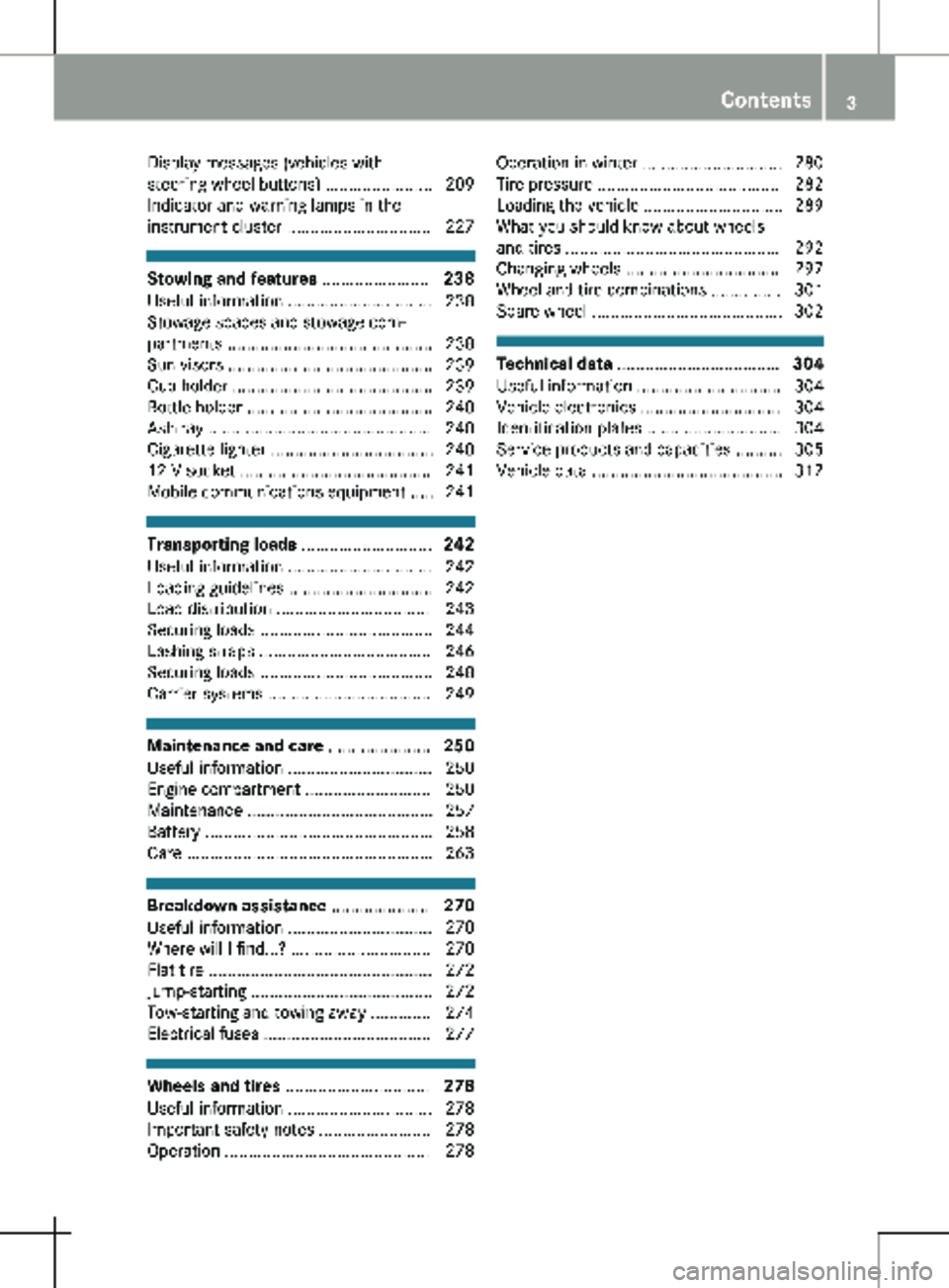
Display messages (vehicles with
steering wheel buttons) .......................
209
Indicator and warning lamps in the
instrument cluster ............................... 227 Stowing and features .......................
238
Useful information ...............................
238
Stowage spaces and stowage com-
partments ............................................ 238
Sun visors ............................................ 239
Cup holder ........................................... 239
Bottle holder ........................................ 240
Ashtray ................................................ 240
Cigarette lighter ................................... 240
12 V socket ......................................... 241
Mobile communications equipment ..... 241 Transporting loads
............................242
Useful information ...............................
242
Loading guidelines ............................... 242
Load distribution ................................. 243
Securing loads ..................................... 244
Lashing straps ..................................... 246
Securing loads ..................................... 248
Carrier systems ................................... 249 Maintenance and care
......................250
Useful information ...............................
250
Engine compartment ........................... 250
Maintenance ........................................ 257
Battery ................................................. 258
Care ..................................................... 263 Breakdown assistance
.....................270
Useful information ...............................
270
Where will I find...? .............................. 270
Flat tire ................................................ 272
Jump-starting ....................................... 272
Tow-starting and towing away ............. 274
Electrical fuses .................................... 277 Wheels and tires ...............................
278
Useful information ...............................
278
Important safety notes ........................ 278
Operation ............................................ 278 Operation in winter .............................. 280
Tire pressure
....................................... 282
Loading the vehicle .............................. 289
What you should know about wheels
and tires .............................................. 292
Changing wheels ................................. 297
Wheel and tire combinations ............... 301
Spare wheel ......................................... 302 Technical data ...................................
304
Useful information ...............................
304
Vehicle electronics .............................. 304
Identification plates ............................. 304
Service products and capacities .......... 305
Vehicle data ......................................... 312 Contents
3
Page 12 of 320

Important safety notes .................. 194
Introduction
................................... 194
Key ................................................ 209
Lamps ............................................ 202
Setting the language ...................... 179
Tires ............................................... 207
Vehicle ........................................... 208
Distance recorder
Displaying (vehicle with steering
wheel buttons) ............................... 183
Displaying (vehicle without steer-
ing wheel buttons) ......................... 177
Setting the display unit (vehicle
without steering wheel buttons) .... 180
Distance recorder
see Trip odometer
Distance warning (warning lamp) .... 235
Distance warning function ............... 149
Door
Changing bulbs (ambient lamp) ..... 104
Display messages (vehicle with
steering wheel buttons) ................. 226
Display messages (vehicle with-
out steering wheel buttons) ........... 208
Indicator lamp ................................ 237
Doors
Central locking/unlocking
(SmartKey) ....................................... 71
Control panel ................................... 44
Emergency locking ........................... 73
Emergency unlocking ....................... 73
Downhill gradients ............................ 142
Drinking and driving ......................... 140
Drinks holder
see Bottle holder
Drinks holder
see Cup holder
Drive program
Automatic transmission ................. 133
Display (DIRECT SELECT lever) ...... 132
Driver's door and front-passenger
door ...................................................... 76
Driver's seat
see Seats
Driving abroad
Fuel ................................................ 141
Low-beam headlamps .................... 141 Mercedes-Benz Service ................. 141
Driving off-road
see Off-road driving
Driving on flooded roads ..................
144
Driving safety systems
ABS (Anti-lock Braking System) ....... 67
BAS (Brake Assist System) .............. 67
EBD (electronic brake force dis-
tribution) .......................................... 68
ESP ®
(Electronic Stability Pro-
gram) ............................................... 68
Important safety information ........... 66
Overview .......................................... 66
Driving system
COLLISION PREVENTION ASSIST .. 149
Display messages (vehicle with-
out steering wheel buttons) ........... 206
Driving systems
Active Parking Assist ..................... 159
ATTENTION ASSIST ........................ 155
Blind Spot Assist ............................ 151
Cruise control ................................ 146
Display messages (vehicle with
steering wheel buttons) ................. 221
Lane Keeping Assist ...................... 153
PARKTRONIC ................................. 156
Rear view camera .......................... 163
Driving tips
Automatic transmission ................. 134
Brakes ........................................... 142
Break-in period .............................. 126
Checking brake lining thickness .... 143
Downhill gradient ........................... 142
Drinking and driving ....................... 140
Driving abroad ............................... 141
Driving in mountainous areas ........ 146
Driving in winter ............................. 144
Driving on flooded roads ................ 144
Driving on wet roads ...................... 143
Exhaust check ............................... 141
Fuel ................................................ 140
General notes ................................ 140
Hydroplaning ................................. 143
Icy road surfaces ........................... 144
Important safety notes .................. 126
Limited braking efficiency on sal-
ted roads ....................................... 142
New brake disks ............................ 143 10
Index
Page 23 of 320

Starting
see Starting (engine)
Starting (engine) ................................
128
Status overview (on-board com-
puter) .................................................. 189
Steering
Display messages (vehicle with
steering wheel buttons) ................. 227
Display messages (vehicle with-
out steering wheel buttons) ........... 208
Warning lamps ............................... 237
Steering wheel
Adjusting ......................................... 95
Button overview ............................... 42
Buttons (on-board computer) ......... 181
Cleaning ......................................... 269
Paddle shifters ............................... 135
Steering wheel paddle shifters ........ 135
Stickers
General safety notes ........................ 29
Stowage net ....................................... 239
Stowage spaces
see Stowage spaces and stow-
age compartments
Stowage spaces and stowage
compartments
Eyeglasses compartment ............... 238
Glove box ....................................... 238
Important safety notes .................. 238
Stowage net ................................... 239
Summer opening
see Convenience opening feature
Summer tires
In winter ........................................ 280
Sun visor
Changing a bulb (mirror lamp) ....... 104
Overview ........................................ 239
Surround lighting (on-board com-
puter) .................................................. 193
Switching air-recirculation mode
on/off ................................................. 123
Switching off the alarm (ATA) ............ 70T
Tachometer ........................................
175Tail lamps
Display messages (vehicle with-
out steering wheel buttons)
........... 202
Replacing bulbs ............................. 108
Trailer display messages (vehicle
with steering wheel buttons) .. 216, 217
Trailer display messages (vehicle
without steering wheel buttons) .... 202
Tailgate
Changing bulbs (ambient lamp) ..... 104
Display messages (vehicle with
steering wheel buttons) ................. 226
Display messages (vehicle with-
out steering wheel buttons) ........... 208
Important safety notes .................... 81
Opening dimensions ...................... 313
Opening/closing from the out-
side .................................................. 81
Replacing light bulbs (signal/
ambient lamp) ................................ 105
Tank
see Fuel tank
Tank contents
Displaying the range (vehicle
with steering wheel buttons) ......... 184
Displaying the range (vehicle
without steering wheel buttons) .... 178
Technical data
Capacities ...................................... 305
Cargo tie-down points .................... 313
Guide rail ....................................... 314
Loading rails .................................. 314
Roof carrier .................................... 314
Tires/wheels ................................. 301
Trailer tow hitch ............................. 315
Vehicle data ................................... 312
Vehicle dimensions ........................ 313
Telephone
Accepting a call ............................. 188
Display message ............................ 227
Introduction ................................... 188
Number from the phone book ........ 188
Redialing ........................................ 189
Rejecting/ending a call ................. 188
Temperature
Coolant (display in the instru-
ment cluster) ................................. 175 Index
21
Page 25 of 320
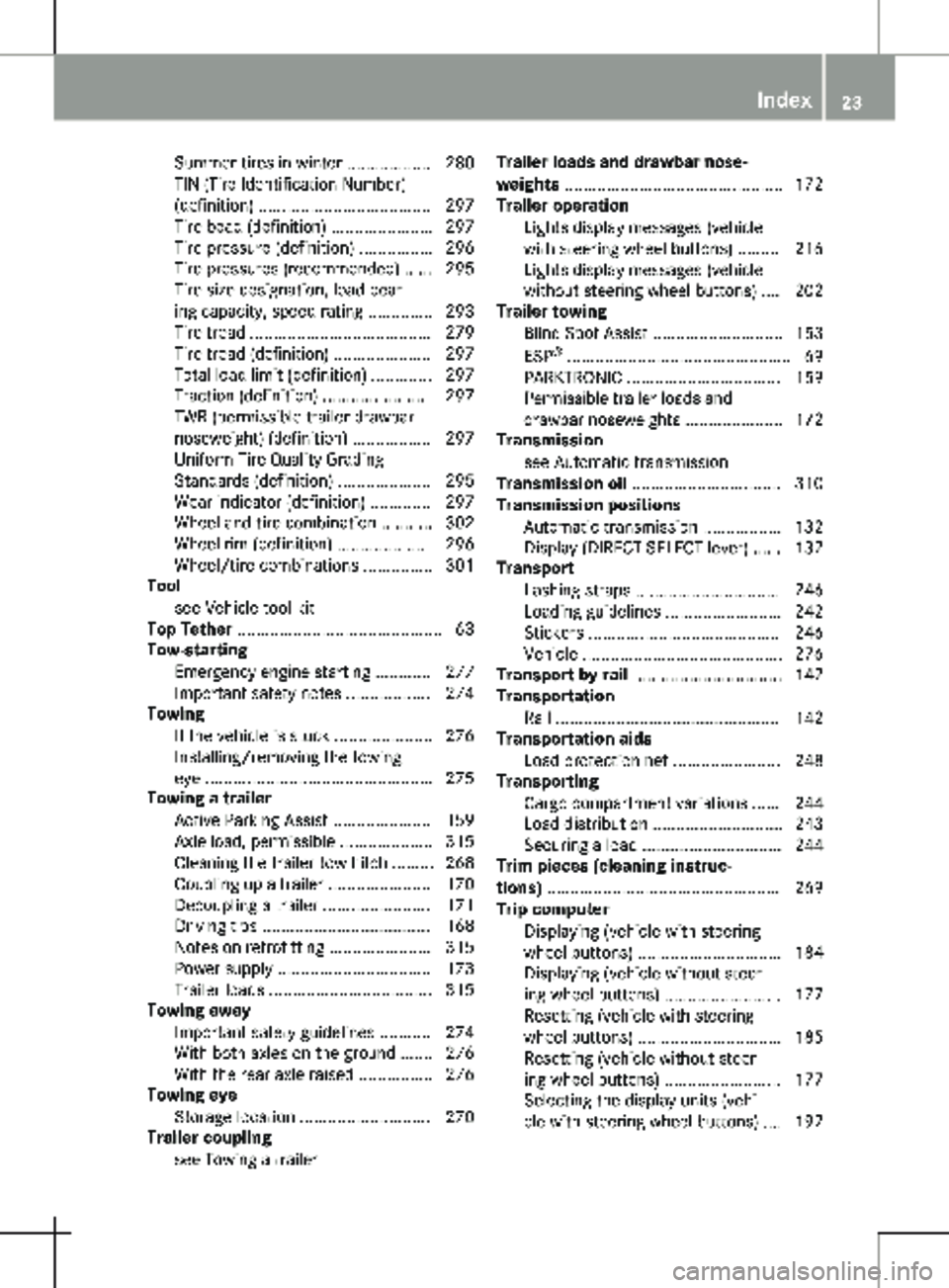
Summer tires in winter .................. 280
TIN (Tire Identification Number)
(definition) .....................................
297
Tire bead (definition) ...................... 297
Tire pressure (definition) ................ 296
Tire pressures (recommended) ...... 295
Tire size designation, load-bear-
ing capacity, speed rating .............. 293
Tire tread ....................................... 279
Tire tread (definition) ..................... 297
Total load limit (definition) ............. 297
Traction (definition) ....................... 297
TWR (permissible trailer drawbar
noseweight) (definition) ................. 297
Uniform Tire Quality Grading
Standards (definition) .................... 295
Wear indicator (definition) ............. 297
Wheel and tire combination ........... 302
Wheel rim (definition) .................... 296
Wheel/tire combinations ............... 301
Tool
see Vehicle tool kit
Top Tether ............................................ 63
Tow-starting
Emergency engine starting ............ 277
Important safety notes .................. 274
Towing
If the vehicle is stuck ..................... 276
Installing/removing the towing
eye ................................................. 275
Towing a trailer
Active Parking Assist ..................... 159
Axle load, permissible .................... 315
Cleaning the trailer tow hitch ......... 268
Coupling up a trailer ...................... 170
Decoupling a trailer ....................... 171
Driving tips .................................... 168
Notes on retrofitting ...................... 315
Power supply ................................. 173
Trailer loads ................................... 315
Towing away
Important safety guidelines ........... 274
With both axles on the ground ....... 276
With the rear axle raised ................ 276
Towing eye
Storage location ............................ 270
Trailer coupling
see Towing a trailer Trailer loads and drawbar nose-
weights
...............................................
172
Trailer operation
Lights display messages (vehicle
with steering wheel buttons) ......... 216
Lights display messages (vehicle
without steering wheel buttons) .... 202
Trailer towing
Blind Spot Assist ............................ 153
ESP ®
................................................ 69
PARKTRONIC ................................. 159
Permissible trailer loads and
drawbar noseweights ..................... 172
Transmission
see Automatic transmission
Transmission oil ................................ 310
Transmission positions
Automatic transmission ................. 132
Display (DIRECT SELECT lever) ...... 132
Transport
Lashing straps ............................... 246
Loading guidelines ......................... 242
Stickers ......................................... 246
Vehicle ........................................... 276
Transport by rail ................................ 142
Transportation
Rail ................................................ 142
Transportation aids
Load protection net ....................... 248
Transporting
Cargo compartment variations ...... 244
Load distribution ............................ 243
Securing a load .............................. 244
Trim pieces (cleaning instruc-
tions) .................................................. 269
Trip computer
Displaying (vehicle with steering
wheel buttons) ............................... 184
Displaying (vehicle without steer-
ing wheel buttons) ......................... 177
Resetting (vehicle with steering
wheel buttons) ............................... 185
Resetting (vehicle without steer-
ing wheel buttons) ......................... 177
Selecting the display units (vehi-
cle with steering wheel buttons) .... 192 Index
23
Page 28 of 320

Windshield washer fluid
Adding ........................................... 256
Windshield wiper
Setting the sensitivity of the rain
sensor (vehicle with steering
wheel buttons) ............................... 193
Setting the sensitivity of the rain
sensor (vehicle without steering
wheel buttons) ............................... 180
Windshield wipers
Problem (malfunction) ................... 113
Rear window wiper ........................ 110
Replacing the wiper blades ............ 110
Switching on/off ........................... 109
Winter driving
Slippery road surfaces ................... 144
Snow chains .................................. 281
Winter operation
General notes ................................ 280
Radiator cover ................................. 34
Summer tires ................................. 280
Winter tires
M+S tires ....................................... 280
Setting a limit speed ...................... 141
Wiper blades
Cleaning ......................................... 266
Important safety notes .................. 110
Replacing (rear window) ................ 112
Replacing (windshield) ................... 111
Service indicator ............................ 110
Workshop
see Qualified specialist workshop26
Index
Page 36 of 320

vehicle. This also includes labeling and docu-
mentation affected by their modifications.
It is their responsibility to certify that:
R the altered vehicle conforms to all applica-
ble standards and regulations affected by
the vehicle alteration
R the altered vehicle continues to comply with
the motor vehicle safety standards and
emissions regulations
R the changes or installation of accessories do
not impair the safety of the vehicle
We are not responsible for any final certifica-
tion or claims regarding product liability or
warranty claims that arise as a result of such
changes. This applies to:
R components, assemblies or systems which
have been altered
R non-compliance with emissions laws and
regulations or with vehicle safety standards
arising as a result of the alterations
R all consequences resulting form the
changed, less safe or even defective vehicle
We do not assume responsibility as the final
stage manufacturer or the consequential prod-
uct liability.
Notes on the engine radiator Even seemingly small changes to the vehicle,
such as attaching a radiator trim for winter
driving or as protection against insects, are
not permitted. Do not cover the radiator. Do
not use thermal mats, insect protection covers
or anything similar.
Doing so can cause the diagnostics system to
display inaccurate values. Some of these val-
ues are legally required and must always be
correct.
Notes for commercial vehicles without
partitions Vehicles, which are approved as commercial
vehicles (N1), do not comply with the
ISO 27956
standard in the respective current
valid version unless equipped with a partition.
The ISO 27956 Standard details the equip-
ment for correct load securing in delivery vehi-
cles. Retrofitting the partition is strongly rec-
ommended when using the vehicle for the
transport of goods, as correct load securing in
vehicles without the partition is difficult to
achieve. Genuine Mercedes-Benz parts
! Air bags and Emergency Tensioning Devi-
ces, as well as control units and sensors for
these restraint systems, may be installed in
the following areas of your vehicle:
R doors
R door pillars
R door sills
R seats
R cockpit
R instrument cluster
R center console
Do not install accessories such as audio sys-
tems in these areas. Do not carry out
repairs or welding. You could impair the
operating efficiency of the restraint sys-
tems.
Have aftermarket accessories installed at a
qualified specialist workshop. H
Environmental note
We supply reconditioned assemblies and
parts which are of the same quality as new
parts. The same New Vehicle Limited War-
ranty applies as for new parts.
The operating safety of the vehicle could be
jeopardized if you use parts, tires and wheels
as well as accessories relevant to safety which
have not been approved by Mercedes-Benz.
This could lead to malfunctions in safety-rele-
vant systems, e.g. the brake system. Only use
genuine Mercedes-Benz parts or parts of equal
quality. Only use tires, wheels and accessories
that have been specifically approved for your
vehicle.
Mercedes-Benz tests genuine Mercedes-Benz
parts, conversion parts and accessories that
have been specifically approved for the type of
vehicle for:
R Reliability
R Safety
R Suitability
Despite ongoing market research, Mercedes-
Benz is unable to assess other parts. Even if
an independent or official approval has been
provided in exceptional cases, Mercedes-Benz
accepts no responsibility for the use of such
parts in Mercedes-Benz vehicles. 34
Introduction
Page 68 of 320

Child-proof lock for sliding door
Sliding door (example: left side of the vehicle)
: Child safety bolt
2 Sliding door released
3 Sliding door secured – then make sure
that the child-proof locks are working
properly.
You can secure each sliding door individually
with the child-proof locks on the sliding doors.
A secured sliding door cannot be opened from
inside the vehicle. When the vehicle is
unlocked, the sliding door can be opened from
the outside. If the electric sliding door is
secured, only the sliding door rear controls are
deactivated. If the electric sliding door is
unlocked, you can open the electric sliding
door using the corresponding Å or Æ
sliding door button in the center console
(Y page
79). Pets in the vehicle
G
WARNING
If you leave animals unsupervised or unse-
cured in the vehicle, they may press buttons
or switches, for instance.
In this way, animals may:
R activate vehicle equipment and become
trapped, for example
R switch systems on or off and thereby
endanger other road users
Furthermore, unsecured animals may be
flung around inside the vehicle in the event
of an accident or abrupt steering or braking maneuver, and thereby injure vehicle occu-
pants. There is a risk of accident and injury.
Never leave animals unattended in the vehi-
cle.
Always secure animals properly when driv-
ing, for instance with a suitable pet carrier. Driving safety systems
Overview
In this section, you will find information about
the following driving safety systems:
R EBD ( Electronic Brake Force Distribution)
R ABS ( Anti-lock Braking System)
R BAS ( Brake A ssist System)
R ESP ®
(Electronic Stability Program) Important safety notes
If you fail to adapt your driving style or if you
are inattentive, the driving safety systems can
neither reduce the risk of accident nor over-
ride the laws of physics. Driving safety sys-
tems are merely aids designed to assist driv-
ing. You are responsible for the distance to the
vehicle in front, for vehicle speed, braking in
good time and for staying in your lane. Always
adapt your driving style to the prevailing road
and weather conditions and maintain a suffi-
cient, safe distance from other road users.
Drive carefully.
Please note that the driving safety systems
described only work optimally when the follow-
ing conditions are fulfilled:
R there is adequate contact between the tires
and the road surface.
R you use winter tires
(M+S tires) with snow
chains if necessary, when the road condi-
tions are wintry.
R the speed information determined by the
vehicle is within the legally prescribed dis-
play accuracy.
Pay particular attention to the information
regarding tires, tire tread and winter operation
under "Wheels and tires" (Y page 278). 66
Driving safety systems
Safety
Page 143 of 320
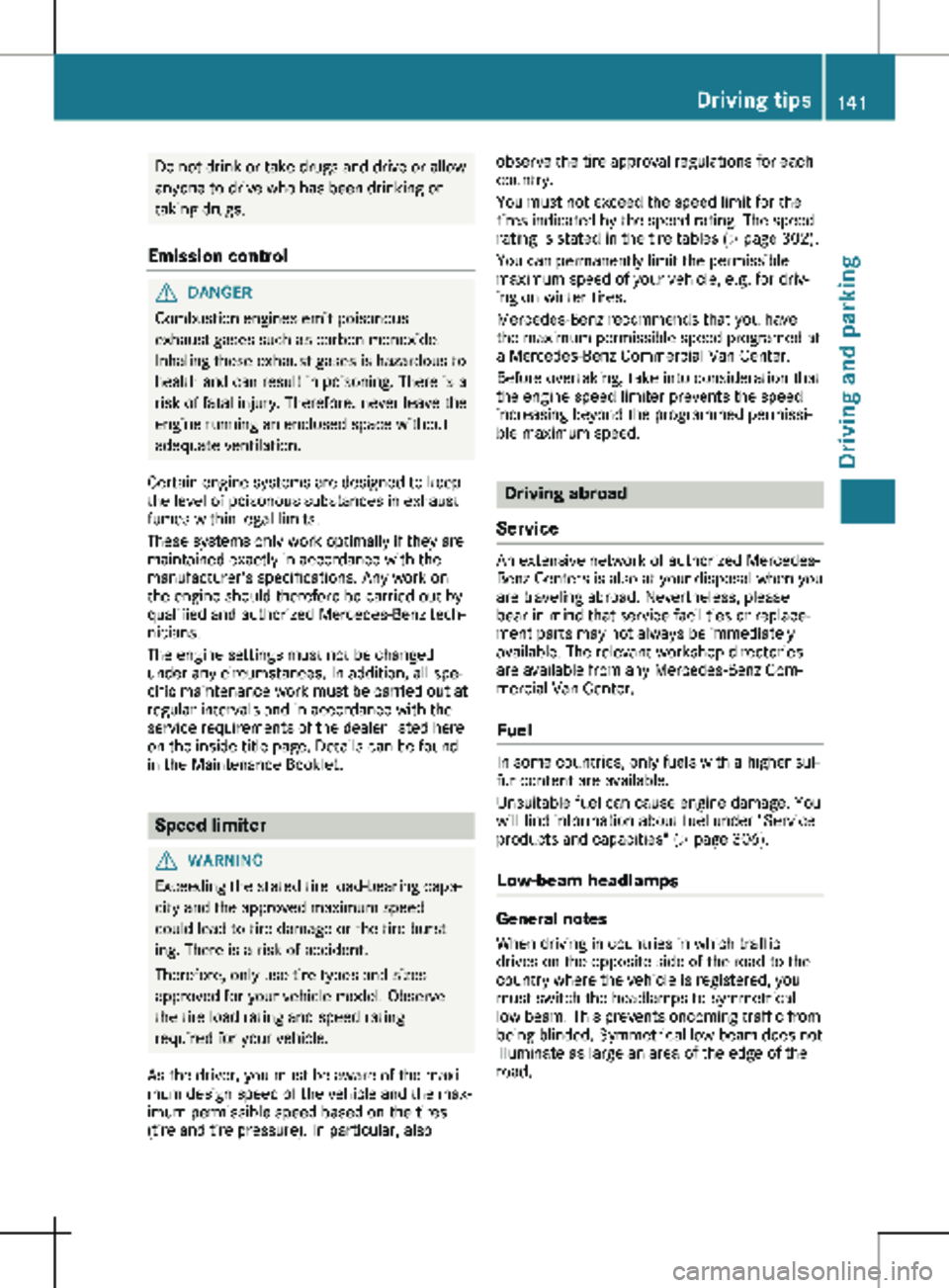
Do not drink or take drugs and drive or allow
anyone to drive who has been drinking or
taking drugs.
Emission control G
DANGER
Combustion engines emit poisonous
exhaust gases such as carbon monoxide.
Inhaling these exhaust gases is hazardous to
health and can result in poisoning. There is a
risk of fatal injury. Therefore, never leave the
engine running an enclosed space without
adequate ventilation.
Certain engine systems are designed to keep
the level of poisonous substances in exhaust
fumes within legal limits.
These systems only work optimally if they are
maintained exactly in accordance with the
manufacturer's specifications. Any work on
the engine should therefore be carried out by
qualified and authorized Mercedes-Benz tech-
nicians.
The engine settings must not be changed
under any circumstances. In addition, all spe-
cific maintenance work must be carried out at
regular intervals and in accordance with the
service requirements of the dealer listed here
on the inside title page. Details can be found
in the Maintenance Booklet. Speed limiter
G
WARNING
Exceeding the stated tire load-bearing capa-
city and the approved maximum speed
could lead to tire damage or the tire burst-
ing. There is a risk of accident.
Therefore, only use tire types and sizes
approved for your vehicle model. Observe
the tire load rating and speed rating
required for your vehicle.
As the driver, you must be aware of the maxi-
mum design speed of the vehicle and the max-
imum permissible speed based on the tires
(tire and tire pressure). In particular, also observe the tire approval regulations for each
country.
You must not exceed the speed limit for the
tires indicated by the speed rating. The speed
rating is stated in the tire tables (Y page
302).
You can permanently limit the permissible
maximum speed of your vehicle, e.g. for driv-
ing on winter tires.
Mercedes-Benz recommends that you have
the maximum permissible speed programed at
a Mercedes-Benz Commercial Van Center.
Before overtaking, take into consideration that
the engine speed limiter prevents the speed
increasing beyond the programmed permissi-
ble maximum speed. Driving abroad
Service An extensive network of authorized Mercedes-
Benz Centers is also at your disposal when you
are traveling abroad. Nevertheless, please
bear in mind that service facilities or replace-
ment parts may not always be immediately
available. The relevant workshop directories
are available from any Mercedes-Benz Com-
mercial Van Center.
Fuel In some countries, only fuels with a higher sul-
fur content are available.
Unsuitable fuel can cause engine damage. You
will find information about fuel under "Service
products and capacities"
(Y page 306).
Low-beam headlamps General notes
When driving in countries in which traffic
drives on the opposite side of the road to the
country where the vehicle is registered, you
must switch the headlamps to symmetrical
low beam. This prevents oncoming traffic from
being blinded. Symmetrical low beam does not
illuminate as large an area of the edge of the
road. Driving tips
141
Driving and parking Z
Page 146 of 320
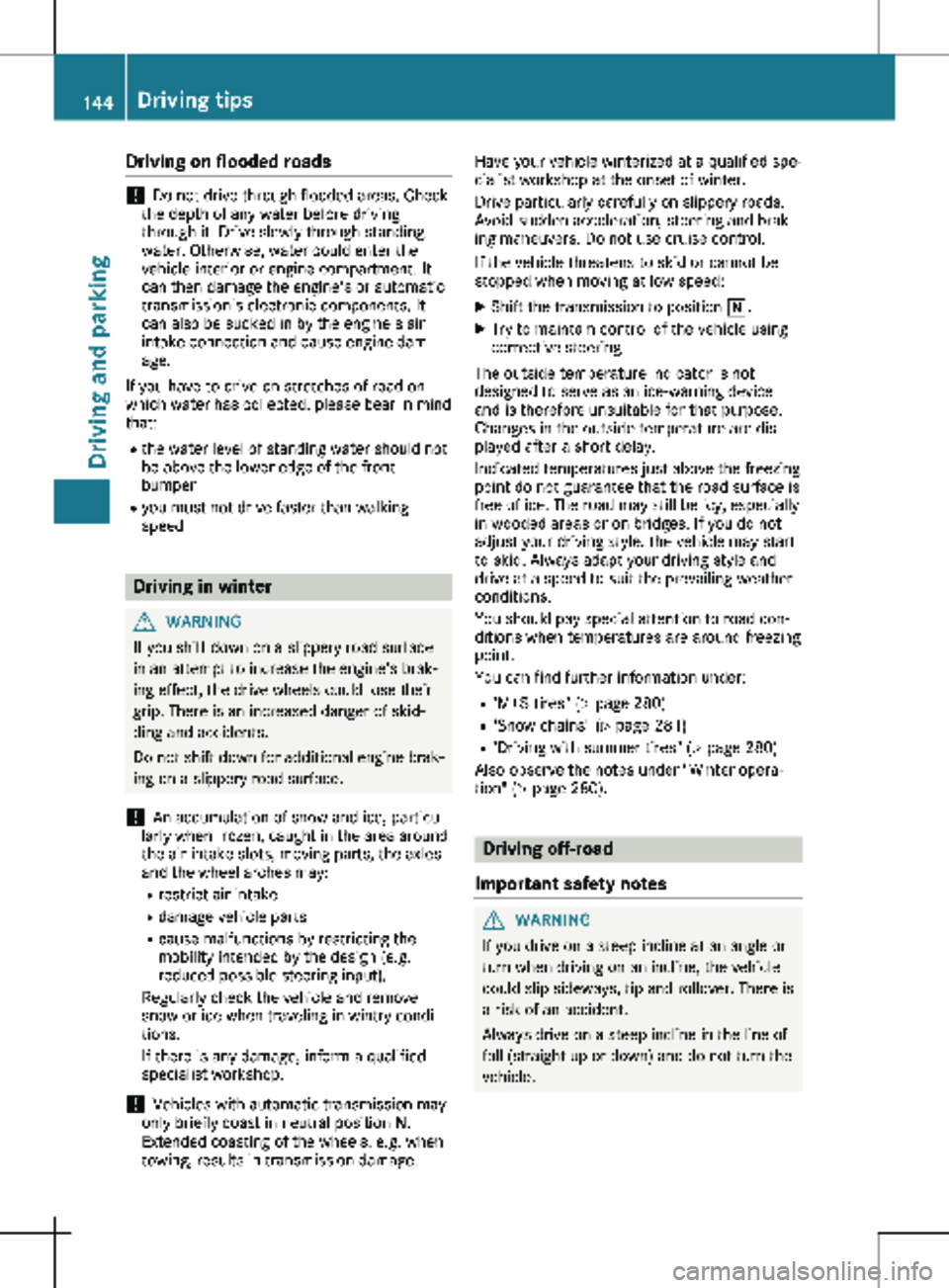
Driving on flooded roads
!
Do not drive through flooded areas. Check
the depth of any water before driving
through it. Drive slowly through standing
water. Otherwise, water could enter the
vehicle interior or engine compartment. It
can then damage the engine's or automatic
transmission's electronic components. It
can also be sucked in by the engine's air
intake connection and cause engine dam-
age.
If you have to drive on stretches of road on
which water has collected, please bear in mind
that: R the water level of standing water should not
be above the lower edge of the front
bumper
R you must not drive faster than walking
speed Driving in winter
G
WARNING
If you shift down on a slippery road surface
in an attempt to increase the engine's brak-
ing effect, the drive wheels could lose their
grip. There is an increased danger of skid-
ding and accidents.
Do not shift down for additional engine brak-
ing on a slippery road surface.
! An accumulation of snow and ice, particu-
larly when frozen, caught in the area around
the air intake slots, moving parts, the axles
and the wheel arches may:
R restrict air intake
R damage vehicle parts
R cause malfunctions by restricting the
mobility intended by the design (e.g.
reduced possible steering input).
Regularly check the vehicle and remove
snow or ice when traveling in wintry condi-
tions.
If there is any damage, inform a qualified
specialist workshop.
! Vehicles with automatic transmission may
only briefly coast in neutral position N.
Extended coasting of the wheels, e.g. when
towing, results in transmission damage. Have your vehicle winterized at a qualified spe-
cialist workshop at the onset of winter.
Drive particularly carefully on slippery roads.
Avoid sudden acceleration, steering and brak-
ing maneuvers. Do not use cruise control.
If the vehicle threatens to skid or cannot be
stopped when moving at low speed:
X Shift the transmission to position i.
X Try to maintain control of the vehicle using
corrective steering.
The outside temperature indicator is not
designed to serve as an ice-warning device
and is therefore unsuitable for that purpose.
Changes in the outside temperature are dis-
played after a short delay.
Indicated temperatures just above the freezing
point do not guarantee that the road surface is
free of ice. The road may still be icy, especially
in wooded areas or on bridges. If you do not
adjust your driving style, the vehicle may start
to skid. Always adapt your driving style and
drive at a speed to suit the prevailing weather
conditions.
You should pay special attention to road con-
ditions when temperatures are around freezing
point.
You can find further information under:
R "M+S tires" ( Y page
280)
R "Snow chains" (Y page 281)
R "Driving with summer tires" (Y page 280)
Also observe the notes under "Winter opera-
tion" (Y page 280). Driving off-road
Important safety notes G
WARNING
If you drive on a steep incline at an angle or
turn when driving on an incline, the vehicle
could slip sideways, tip and rollover. There is
a risk of an accident.
Always drive on a steep incline in the line of
fall (straight up or down) and do not turn the
vehicle. 144
Driving tips
Driving and parking
Page 267 of 320
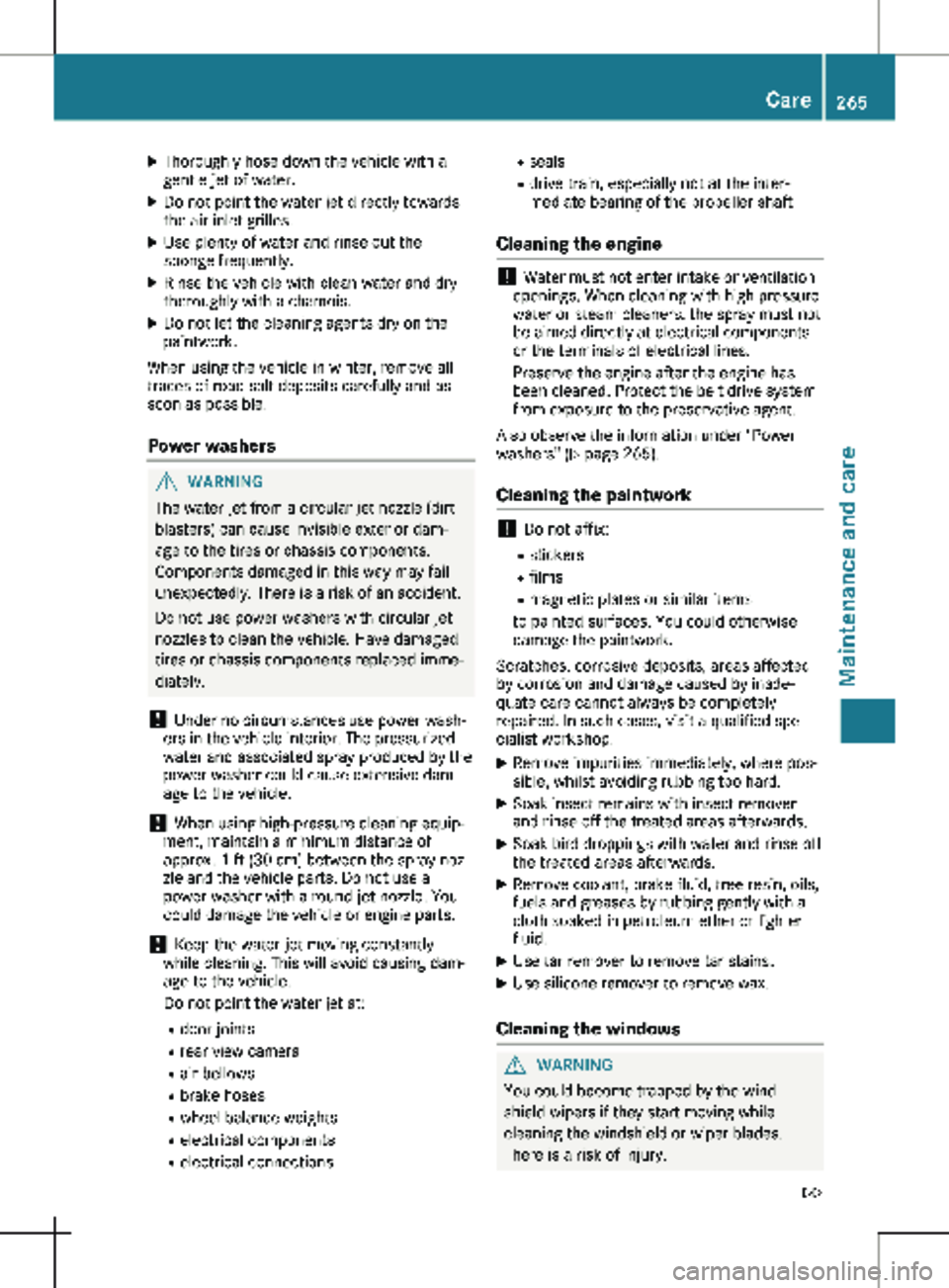
X
Thoroughly hose down the vehicle with a
gentle jet of water.
X Do not point the water jet directly towards
the air inlet grilles.
X Use plenty of water and rinse out the
sponge frequently.
X Rinse the vehicle with clean water and dry
thoroughly with a chamois.
X Do not let the cleaning agents dry on the
paintwork.
When using the vehicle in winter, remove all
traces of road salt deposits carefully and as
soon as possible.
Power washers G
WARNING
The water jet from a circular jet nozzle (dirt
blasters) can cause invisible exterior dam-
age to the tires or chassis components.
Components damaged in this way may fail
unexpectedly. There is a risk of an accident.
Do not use power washers with circular jet
nozzles to clean the vehicle. Have damaged
tires or chassis components replaced imme-
diately.
! Under no circumstances use power wash-
ers in the vehicle interior. The pressurized
water and associated spray produced by the
power washer could cause extensive dam-
age to the vehicle.
! When using high-pressure cleaning equip-
ment, maintain a minimum distance of
approx. 1 ft (30 cm
) between the spray noz-
zle and the vehicle parts. Do not use a
power washer with a round-jet nozzle. You
could damage the vehicle or engine parts.
! Keep the water jet moving constantly
while cleaning. This will avoid causing dam-
age to the vehicle.
Do not point the water jet at:
R door joints
R rear view camera
R air bellows
R brake hoses
R wheel balance weights
R electrical components
R electrical connections R
seals
R drive train, especially not at the inter-
mediate bearing of the propeller shaft
Cleaning the engine !
Water must not enter intake or ventilation
openings. When cleaning with high pressure
water or steam cleaners, the spray must not
be aimed directly at electrical components
or the terminals of electrical lines.
Preserve the engine after the engine has
been cleaned. Protect the belt drive system
from exposure to the preservative agent.
Also observe the information under "Power
washers"
(Y page 265).
Cleaning the paintwork !
Do not affix:
R stickers
R films
R magnetic plates or similar items
to painted surfaces. You could otherwise
damage the paintwork.
Scratches, corrosive deposits, areas affected
by corrosion and damage caused by inade-
quate care cannot always be completely
repaired. In such cases, visit a qualified spe-
cialist workshop.
X Remove impurities immediately, where pos-
sible, whilst avoiding rubbing too hard.
X Soak insect remains with insect remover
and rinse off the treated areas afterwards.
X Soak bird droppings with water and rinse off
the treated areas afterwards.
X Remove coolant, brake fluid, tree resin, oils,
fuels and greases by rubbing gently with a
cloth soaked in petroleum ether or lighter
fluid.
X Use tar remover to remove tar stains.
X Use silicone remover to remove wax.
Cleaning the windows G
WARNING
You could become trapped by the wind-
shield wipers if they start moving while
cleaning the windshield or wiper blades.
There is a risk of injury. Care
265
Maintenance and care
Z